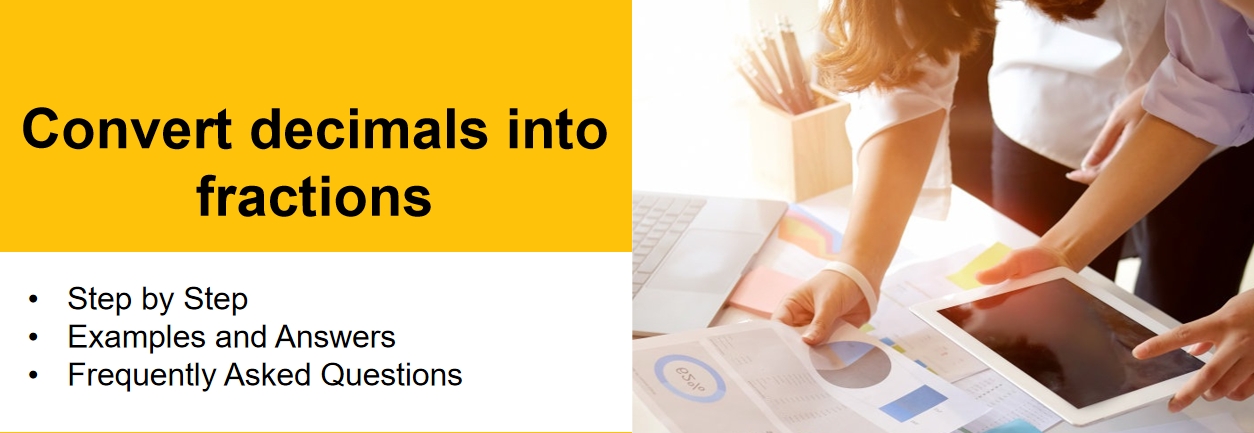0.375 as a fraction
Definition
Converting a decimal to a fraction is a fundamental concept in mathematics. It involves expressing a decimal number as a fraction, which is a ratio of two integers. This process is useful in various mathematical applications, such as simplifying calculations, comparing numbers, and solving equations.
 There are several methods to convert a decimal to a fraction, including the long division method, the shortcut method, and the use of mathematical properties. In this blog, we will explore these methods and provide step-by-step solutions to convert the decimal 0.375 to a fraction.
There are several methods to convert a decimal to a fraction, including the long division method, the shortcut method, and the use of mathematical properties. In this blog, we will explore these methods and provide step-by-step solutions to convert the decimal 0.375 to a fraction.
Step by Step Solution
To convert 0.375 to a fraction, we can follow these steps:
Step 1: Identify the place value of the last digit in the decimal. In this case, the last digit is 5, which is in the thousandths place.
Step 2: Write the decimal as a fraction with the denominator as a power of 10. Since the last digit is in the thousandths place, the denominator will be 1000.
Step 3: Simplify the fraction if possible. To simplify a fraction, we divide both the numerator and denominator by their greatest common divisor (GCD).
Let's apply these steps to convert 0.375 to a fraction:
Step 1: The last digit is 5, which is in the thousandths place.
Step 2: Writing 0.375 as a fraction with a denominator of 1000, we get:
0.375 = 375/1000
Step 3: To simplify the fraction, we divide both the numerator and denominator by their GCD. In this case, the GCD of 375 and 1000 is 125. Dividing both by 125, we get:
375/1000 = 3/8
Therefore, 0.375 as a fraction is 3/8.
Mixed Fraction
A mixed fraction is a combination of a whole number and a proper fraction. To express 0.375 as a mixed fraction, we need to determine the whole number part and the fractional part.
Since 0.375 is less than 1, the whole number part is 0. The fractional part can be obtained by subtracting the whole number part from the decimal. In this case, the fractional part is 0.375.
Therefore, 0.375 as a mixed fraction is 0 3/8.
Simplest Form
The simplest form of a fraction is when the numerator and denominator have no common factors other than 1. To simplify a fraction, we divide both the numerator and denominator by their GCD.
In the previous step, we simplified 375/1000 to 3/8. However, we can simplify it further by dividing both the numerator and denominator by their GCD, which is 1 in this case.
Therefore, the simplest form of 0.375 as a fraction is 3/8.
Related Examples and Answers
Example 1: Convert 0.25 to a fraction.
Step 1: The last digit is 5, which is in the hundredths place.
Step 2: Writing 0.25 as a fraction with a denominator of 100, we get:
0.25 = 25/100
Step 3: To simplify the fraction, we divide both the numerator and denominator by their GCD. In this case, the GCD of 25 and 100 is 25. Dividing both by 25, we get:
25/100 = 1/4
Therefore, 0.25 as a fraction is 1/4.
Example 2: Convert 0.6 to a fraction.
Step 1: The last digit is 6, which is in the tenths place.
Step 2: Writing 0.6 as a fraction with a denominator of 10, we get:
0.6 = 6/10
Step 3: To simplify the fraction, we divide both the numerator and denominator by their GCD. In this case, the GCD of 6 and 10 is 2. Dividing both by 2, we get:
6/10 = 3/5
Therefore, 0.6 as a fraction is 3/5.
Frequently Asked Questions
Q: Can all decimals be converted to fractions? A: Yes, all decimals can be converted to fractions. However, the resulting fraction may not always be a simple or whole number fraction.
Q: What is the easiest method to convert a decimal to a fraction? A: The easiest method is to write the decimal as a fraction with the denominator as a power of 10 and simplify if possible.
Q: How can I check if my fraction is in simplest form? A: To check if a fraction is in simplest form, ensure that the numerator and denominator have no common factors other than 1.
Q: Can a decimal have an infinite fraction representation? A: Yes, some decimals, such as pi (π) or e, have infinite fraction representations.
Q: Why is converting decimals to fractions important? A: Converting decimals to fractions is important in various mathematical applications, such as simplifying calculations, comparing numbers, and solving equations.
In conclusion, converting a decimal to a fraction is a valuable skill in mathematics. By following the step-by-step solution and understanding the concept of simplifying fractions, we can convert decimals to fractions accurately. This process allows us to express decimal numbers as ratios of integers, making them easier to work with in various mathematical contexts.